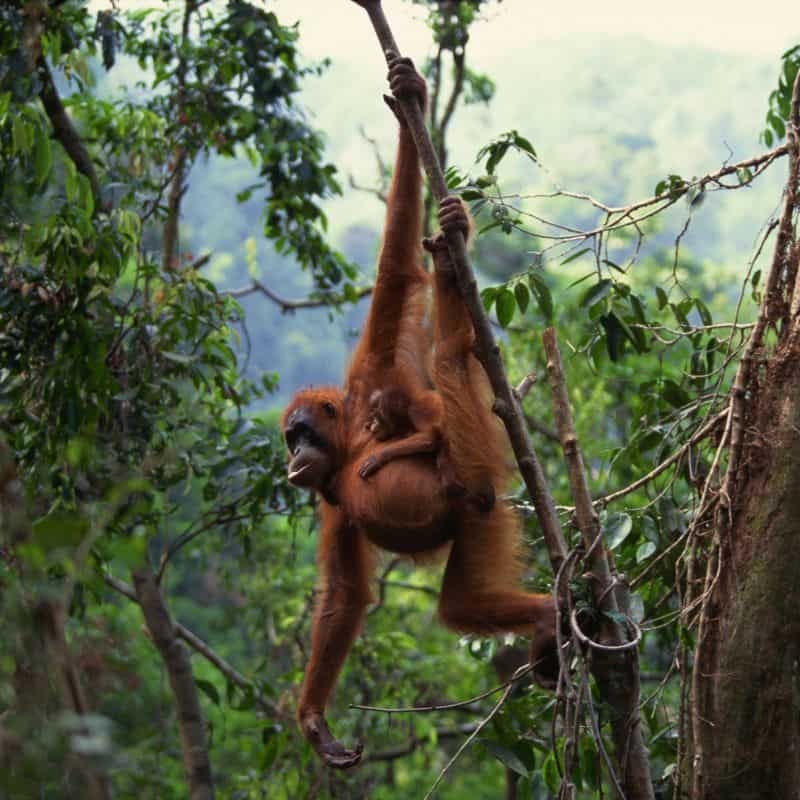
Honestly, that’s a great question! Knowing the habitat and distribution of orangutans can help us understand their way of life. These amazing primates primarily thrive in the rainforests of Southeast Asia. Yet, their homes are rapidly changing, making it important for us to dive into their world and learn more about where they live and why it matters.
Orangutan Species and Their Habitats
There are three main species of orangutans: the Sumatran orangutan, the Bornean orangutan, and the Tapanuli orangutan. Each species has its own unique habitat, but they all share a common preference for tropical rainforests.
The Sumatran orangutan primarily inhabits the northern regions of Sumatra, Indonesia, where the forests are dense and rich in biodiversity. These areas offer a perfect environment for them to thrive, with plenty of fruit, leaves, and flowers to munch on. On the other hand, the Bornean orangutan can be found on the island of Borneo, which is shared by Indonesia, Malaysia, and Brunei. Their habitats usually occur in the lowland forests and peat swamps, where they have ample food and space to move around.
Then there’s the Tapanuli orangutan, a recently recognized species that resides in a small region in North Sumatra. This unique population highlights the importance of conserving their specific habitat, as it supports a very limited number of these incredible creatures.
The Importance of Rainforests
Rainforests are sometimes called the “lungs of the Earth,” and for good reason! They play a crucial role in producing oxygen and maintaining our planet’s climate. Orangutans depend on these forests not only for food but also for shelter. These dense canopies provide them with protection from predators and harsh weather.
The lush environment is vital for their survival, as orangutans have specialized diets primarily consisting of ripe fruits. Think of them as the ultimate fruit connoisseurs! Their foraging habits also help disperse seeds, which promotes forest growth and biodiversity. So, when orangutans thrive, they also contribute to the health of their ecosystem.
Here’s the thing: our rainforests are under constant threat from deforestation, logging, and agriculture. As we learn more about orangutans’ habitats, it becomes clear how important it is to protect these precious ecosystems for the animals and ultimately for ourselves.
Climate and Geography: A Perfect Match
The climate where orangutans live is typically warm and humid, with plenty of rainfall throughout the year. Most rainforests see between 60 to 100 inches of rain annually, creating a dense and diverse habitat.
Geographically, both Sumatra and Borneo feature rugged mountains, vast river systems, and lowland areas that are ideal for orangutans to roam. The complex topography provides various micro-habitats, allowing different species of plants and animals to coexist. Just picture how these different layers create a multi-dimensional home for the orangutans, making it easier for them to find food, build nests, and avoid danger.
In addition to geography, the specific locations within the forests matter too. Orangutans are often spotted in the canopy layer, which is where they build their nests for sleeping and resting. This helps them stay away from ground predators while still being close to their food sources.
Threats to Orangutan Habitats
Unfortunately, orangutans face several challenges that threaten their natural habitats. Deforestation is perhaps the biggest concern, fueled by logging, agricultural expansion, and palm oil plantations. It’s alarming how much of their habitat has been lost over the years.
You might be wondering how serious the situation is. Reports show that orangutan populations have plummeted by more than 50% in the last 60 years. That’s a staggering decline! When trees are cut down, it not only destroys their homes but also disrupts the entire ecosystem. This makes it harder for orangutans to find food and shelter, leading to further population decline.
Other threats include climate change, which can alter their habitats and food availability. As global temperatures rise, it impacts the forests they rely on. It’s a reminder that the fate of these remarkable creatures is closely intertwined with the health of our planet.
Conservation Efforts and Hope for the Future
Despite the challenges, there’s a growing movement to protect orangutans and their habitats. Organizations are working tirelessly to raise awareness and implement conservation efforts. For example, some projects focus on reforestation, where native trees are planted to restore degraded areas.
Additionally, sustainable practices in agriculture can help limit the destruction of orangutan habitats. By supporting companies that use eco-friendly methods, consumers can make a difference. It’s like a ripple effect: every positive action can contribute to protecting these incredible animals and their homes.
Let me explain further: community engagement is also key. Local communities are often the best stewards of their environment. By providing education and resources, conservationists empower locals to protect their natural resources. When people see the value in their forests, they are more likely to take action to conserve them.
Understanding Orangutan Behavior in Their Habitat
Orangutans are highly intelligent and social creatures. They spend a lot of time in trees, where they find food, build nests, and raise their young. Their arboreal lifestyle allows them to effectively navigate the complex layout of their forest homes.
One interesting aspect of orangutan behavior is their use of tools. They have been known to use sticks to extract insects or create makeshift bridges between tree branches. Imagine watching a clever orangutan fashioning a tool to help it reach a tasty snack! This behavior not only showcases their intelligence but also highlights their close relationship with their habitat.
Moreover, orangutans have a unique social structure. Adult females usually raise their young alone, which can be a demanding job. Mothers teach their offspring vital skills, like how to find food and build nests. Their nurturing nature reflects the importance of a stable habitat for successful parenting. When their environment is threatened, it directly impacts their survival and the future of their species.
Understanding where orangutans live isn’t just about geography; it’s about recognizing the intricate connections between these incredible animals, their habitats, and our planet. Their survival is crucial not only for the biodiversity of Southeast Asian rainforests but also for the health of our global ecosystem.
As we navigate the challenges of deforestation and climate change, it becomes essential to support conservation efforts. By protecting rainforests and the creatures that inhabit them, we’re ensuring a healthier, richer world for all of us. So next time you think of orangutans, remember their home—the lush, vibrant forests—and the role we can all play in keeping it alive.

